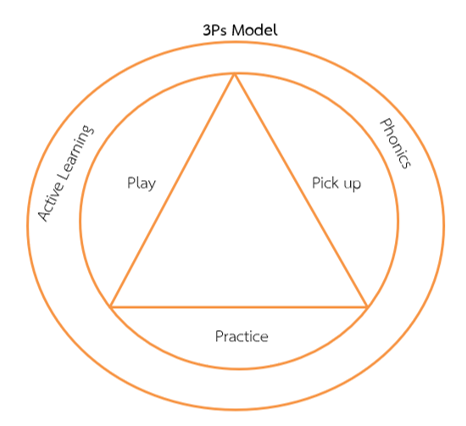การได้มาและการเรียนรู้ภาษาอังกฤษเป็นภาษาที่สองของเด็กปฐมวัย
Main Article Content
บทคัดย่อ
ภาษาเป็นเครื่องมือสำคัญในการช่วยพัฒนาบุคคลให้มีองค์ความรู้และทักษะที่จำเป็นในการประกอบอาชีพโดยเฉพาะในยุคปัจจุบันที่เป็นสังคมแห่งการเปลี่ยนแปลง ประเทศต่าง ๆจึงต้องการให้พลเมืองของตนเป็นบุคคลที่มีความรู้ความสามารถเพื่อพัฒนาประเทศให้ก้าวทันความเปลี่ยนแปลงอยู่เสมอ อย่างไรก็ตามความรู้ที่มีในการเผยแพร่นั้นส่วนใหญ่ใช้ภาษากลางที่เป็นที่รู้จักกันดี โดยเฉพาะอย่างยิ่ง ภาษาอังกฤษ ซึ่งถือเป็นภาษาที่สองหลักในหลายประเทศที่คนใช้มากที่สุดภาษาหนึ่ง ในประเทศไทยการจัดการเรียนการสอนภาษาอังกฤษ ปัจจุบันเป็นการสอนในด้านต่างๆ คือ การฟัง พูด อ่านและเขียน โดยหลักการสอนใช้วิธีสอนแบบการอ่านเป็นคำและเป็นประโยคซึ่งเน้นการท่องจำคำศัพท์ การแปลความหมายของคำและการอ่าน ซึ่งแม้ว่าสังคมโลกจะมีการเปลี่ยนแปลงไปมากเท่าใด ความสามารถในการใช้ภาษาอังกฤษของเด็กไทยก็ยังคงต้องพัฒนากันอย่างต่อเนื่อง บทความนี้มุ่งนำเสนอข้อมูลเบื้องต้นเพื่อทำความเข้าใจเกี่ยวกับการได้มาซึ่งภาษาที่สองและการเรียนรู้ภาษาอังกฤษเป็นภาษาที่สองในเด็กปฐมวัย รวมถึงการจัดการเรียนโดยใช้ภาษาอังกฤษเป็นภาษาที่สองในชั้นเรียนปฐมวัยโดยครูไทย พร้อมทั้งวิธีการส่งเสริมภาษาอังกฤษเป็นภาษาที่สองให้กับเด็กปฐมวัยและการนำเทคโนโลยีมาประกอบการพัฒนาการเรียนรู้ภาษาอังกฤษเป็นภาษาที่สองในระดับปฐมวัย
Article Details

อนุญาตภายใต้เงื่อนไข Creative Commons Attribution-NonCommercial-NoDerivatives 4.0 International License.
เอกสารอ้างอิง
กัญญาณัฐ์ เตโชติอัศนีย์. (2562). ผลการจัดอันดับความสามารถในการใช้ภาษาอังกฤษ โดยดัชนี EF English Proficiency
Index ปี 2019. สืบค้น จาก https://thestandard.co/ef-english-proficiency-index-2019/.
เกวลี ผาใต้ พิเชนทร์ จันทร์ปุ่ม และอภิวัฒน์ วัฒนะสุระ. (2561). สื่อการเรียนรู้ด้วยเทคโนโลยีมิติเสมือนจริง เรื่อง คำศัพท์ภาษาอังกฤษสัตว์โลกน่ารู้. วารสารโครงงานวิทยาการคอมพิวเตอร์และเทคโนโลยีสารสนเทศ. 4 (1). 23 – 28.
จันทิมา เคลือบสำราญ จุฑาทิพย์ แสนวัฒน์ ก้องเกียรติ ไกรยสวน และอภิวัฒน์ กิ่งแสง. (2564). การพัฒนาทักษะการฟังและพูดภาษาอังกฤษ ผ่านสื่อมัลติมีเดีย ระดับปฐมวัย. วารสารวิชาการมหาวิทยาลัยการจัดการและเทคโนโลยีอีสเทิร์น. 18 (1), 119 – 124.
ชลิตา สุนันทาภรณ์. (2561). เรียนปนเล่น เล่นปนเรียน: กระบวนการเรียนรู้ที่เหมาะสมสำหรับเด็กปฐมวัย. สืบค้นจาก: https://thepotential.org/knowledge/play-based-learning/
เตือนจิตต์ จิตต์อารี. (2548). แปลให้เป็นแล้วเก่ง. กรุงเทพฯ : อมรินทร์พริ้นติ้ง.
บัลลังก์ โรหิตเสถียร. (2562). ยกระดับการสอนภาษาอังกฤษ. สืบค้นจากhttps://www.moe.go.th/%E0%B8%A2%E0%B8%81%E0%B8%A3%E0%B8%B0%E0%B8%94%E0%B8
%B1%E0%B8%9A%E0%B8%81%E0%B8%B2%E0%B8%A3%E0%B8%AA%E0%B8%AD%E0%B8%99%
E0%B8%A0%E0%B8%B2%E0%B8%A9%E0%B8%B2%E0%B8%AD%E0%B8%B1%E0%B8%87%E0%B8
%81%E0%B8%A4/
ดียู ศรีนราวัฒน์ และชลธิชา บำรุงรักษ์. (2558). ภาษาและภาษาศาสตร์. กรุงเทพฯ : โรงพิมพ์มหาวิทยาลัยธรรมศาสตร์.
พรรณวลัย เกวะระ. (2559). การเรียนภาษาอังกฤษแบบวิทยภาษาบูรณาการ: แนวคิดและมุมมองสำหรับครูไทย. วารสารศึกษาศาสตร์. 27 (1), 28 – 40.
อมรรัตน์ วัฒนาธร. (2563). การเตรียมครูสำหรับการสอนในโรงเรียนหลักสูตรสองภาษา: กรณีมหาวิทยาลัยพะเยา. วารสารศึกษาศาสตร์ มหาวิทยาลัยนเรศวร. 22 (4), 351 – 364.
อินทิรา ศรีประสิทธิ์ (2552). ทฤษฎีใหม่ในการสอนภาษาอังกฤษ สำหรับคนไทยที่รวมการวางพื้นฐานด้วย Phonemic awareness & Phonics ตามด้วยการสอนอ่านเป็นคำ (whole language) เพื่อแก้ปัญหาอาการภาษาอังกฤษบกพร่อง (dyslexia) ของคนไทย. ในเอกสาร การอบรมครูในสภาพแวดล้อมที่มีนักเรียนเป็นศูนย์กลางการเรียนรู้ วันที่ 24 - 26 มีนาคม 2552 (หน้า 1 - 14). กรุงเทพฯ : UNESCO-APEID.
รวี ศิริปริชยากร. (2562). การพัฒนารูปแบบการเรียนการสอนภาษาอังกฤษโดยบูรณาการ เทคนิค Phonics และการเรียนรู้แบบ Active learning เพื่อส่งเสริมทักษะการอ่านออกเสียงภาษาอังกฤษและการสร้างเกม Phonics สำหรับเด็กปฐมวัย ของนักศึกษาชั้นปีที่ 2 มหาวิทยาลัยสวนดุสิต ศูนย์ฯ นครนายก. กรุงเทพฯ: มหาวิทยาลัยสวนดุสิต.
วาสนา เจริญไทย. (2557). ผลการจัดการเรียนรู้เชิงรุกที่มีต่อผลสัมฤทธิ์ทางการเรียนและความสามารถในการแก้ปัญหาทางคณิตศาสตร์ เรื่อง เศษส่วน ของนักเรียนชั้นมัธยมศึกษาปีที่ 1. วิทยานิพนธ์ วท.ม. (คณิตศาสตร์ศึกษา). ชลบุรี: บัณฑิตวิทยาลัย มหาวิทยาลัยบูรพา.
สำนักงานเลขาธิการสภาการศึกษา. (2560). แผนการศึกษาชาติ พ.ศ. 2560 – 2579. กรุงเทพฯ : บริษัทพริกหวานกราฟฟิค จำกัด.
Akkari, A. (1998). Bilingual education: Beyond Linguistic Instrumentalization. Bilingual Research Journal, 22, 103-125. 10.1080/15235882.1998.10162718
Alba, J.M. (2021). Synthetic phonics strategies to improve reading and writing for English as a second language students. Retrieved from http://www.proquest.com.
Alfadil, M. (2020). Effectiveness of virtual reality game in foreign language vocabulary acquisition. Computer and Education,153, 1-13. https://doi.org/10.1016/ j.compedu.2020.103893
Arkorful, V., & Abaidoo, N. (2015). The role of e-learning, advantages and disadvantages of its adoption in higher education. International Journal of Instructional Technology and Distance Learning, 12(1), 29–42.
Barkley, E. F. (2010). Student engagement techniques: A handbook for college faculty. San Francisco: Jossey-Bass.
Bodrova, E., & D.J. Leong. 2007. Tools of the mind: The Vygotskian approach to early childhood education. 2nd ed. Upper Saddle River, NJ: Pearson Education/ Merril
Brummelman, E., Grapsas., S. & Van Der Kooiji, K. (2022). Parental praise and children’s exploration: A virtual reality experiment. Scientific Reports, 12(4967). https://doi.org/10.1038/s41598-022-08226-9
Chen, J.-Q., & Chang, C. (2006). Using computers in early childhood classrooms: Teachers’ attitudes, skills and practices. Journal of Early Childhood Research, 4(2), 169–188.
Chomsky, N. (1959). Review of Verbal Behavior by B.F. Skinner. Language, 35, 26-58.
Gupta, A. (2019). Principles and Practices of Teaching English Language Learners. International Education Studies, 12(7), 49-57
Kalayci, G. & Oz, H. (2018). Parental involvement in English language education. Understanding parents’ perceptions. International Online Journal of Education and Teaching, 5(4), 832-847.
Klein, W. (1990). Second Language Acquisition. London: Cambridge University Press.
Krashen, S. (1987). School libraries, public libraries, and the NAEP reading scores. School Library Media Quarterly.
Krashen, S., Dulay, H., & Burt, M. (1982). Language two. Nova Iorque: Oxford University Press.
Krashen, S. D., & Terrell, T. D. (1983). The Natural Approach: Language Acquisition in the Classroom. Hemel Hempstead: Prentice Hall International English Language Teaching.
Ilyosovn, N. A. (2020). The Importance of English Language. International Journal on Orange Technologies, 2(1), 22-24. Retrieved from https://journals.researchparks.org/index.php/IJOT/article/view/478
Neumann M., Hood M. & Neumann D. L. (2009). The scaffolding of emergent literacy skills in the home environment: A case study. Early Childhood Education Journal, 36 (4), 313-319.
Ourairat, A. (2011). Bilingual curriculum development and implementation in Thailand: A case study of Rungsit Bilingual School (Doctoral dissertation). Bangkok: Rungsit University.
ParentCo. (2021). The best age for kids to learn a second language. Retrieve from https://www.parent.com/blogs/conversations/the-best-age-for-kids-to-learn-a-second-language
Piaget, J. (1972). Intellectual evolution for adolescence to adulthood. Human Development. 19, 1-12.
Richards, J. C. (2006). Communicative Language Teaching Today. Cambridge: Cambridge University Press.
Robertson, N., Morrissey, A.-M. & Rouse, E. (2018). Play-based learning can set your child up for success at
school and beyond. Retrieve from
Robertson, K. & Ford, K. (2009). Language acquisition: An overview. Retrieve from https://www.colorincolorado.org/article/language-acquisition-overview
Rosenshine, B. & Guenther, J. (1992). Using scaffolds for teaching higher level cognitive strategies: In teaching for thinking. Virginia: National Association of Secondary School.
Vygotsky, L.S. (1978). Mind in society: the developmental of higher psychological process. Cambridge, MA: Harvard University Press.
Zhou, Yahan. (2020). The influence of family on children’s second language learning. Major Papers. 112.


